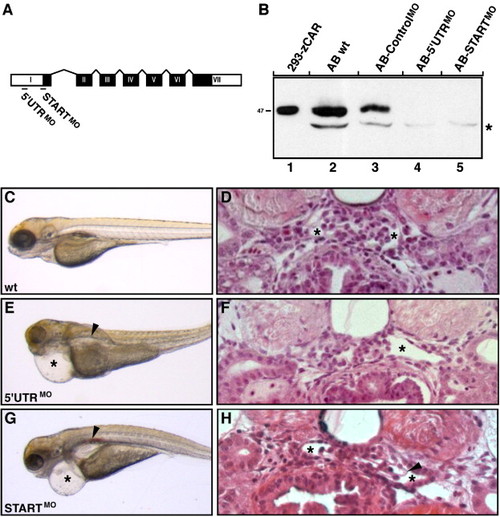
CAR morphants display phenotypes associated with kidney failure. (A) Two antisense oligonucleotide morpholinos (MO), one complementary to the 5′ UTR region (5′ UTRMO) and the other to the region harboring the ATG site (STARTMO), were designed to bind to CAR mRNA and block translation. The seven exons of the CAR gene, encoding the CAR protein, are shown in black boxes with roman letters. The 52UTR and 32UTR regions are marked with white boxes. Exons and introns are not drawn to scale. (B) The morpholino knockdown efficiency was verified by immunoblot analysis on total protein lysates isolated from five individual zebrafish embryos at 48 hpf. Lysates were separated under reducing conditions and CAR was detected using the anti-CAR SIV antibodies. The CAR protein decreased to undetectable levels in both CAR morphants (lanes 4 and 5) as compared to wild type (wt) embryos (lane 2) and controlMO morphants (lane 3). Exogenously expressed zebrafish CAR (zCAR) was used as control for the molecular size (lane 1). The position of the molecular weight marker (kDa) is indicated to the left and asterisk indicates non-specific staining. (C, E and G) Wild type (wt) larvae and CAR morphants were visualized by regular light microscopy at 96 hpf. While wild type larvae developed normally (C), injection of both CAR specific morpholinos results in morphants with cardiac edema (asterisks) and renal cysts (arrowheads) (E and G). (D, F and H) Transversal sections through the pronephric glomeruli of wild type larvae and CAR morphants at 96 hpf. Both CAR morphants (F and H) display enlarged Bowman′s space (asterisks) when compared to wild type larvae (D). In addition, a less densely organized glomerular tuft is seen in the STARTMO morphant (H, arrowhead). No gross histological differences in surrounding tissues could be observed between wild type larvae and CAR morphants (D, F and H). Data shown are a representative larvae/morphant for the indicated time point.
|

